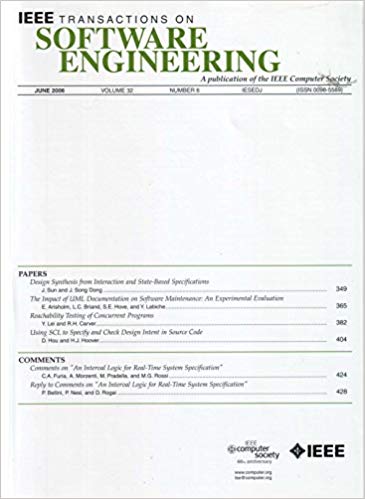所见即所得:物联网最终用户编程的原型生成
IF 5.6
1区 计算机科学
Q1 COMPUTER SCIENCE, SOFTWARE ENGINEERING
引用次数: 0
摘要
随着物联网技术的快速发展,以智能家居为代表的物联网系统变得无处不在。为了支持个性化的用户需求,这样的系统需要最终用户编程范例。这种范例允许最终用户使用TAP(触发-操作编程)规则来描述他们的需求,这些规则可以按需部署。然而,编写TAP规则很容易出错,并且考虑到这些效果的上下文敏感性,最终用户通常不知道他们编写的规则的实际效果。在部署之前验证TAP规则是非常可取的。不幸的是,到目前为止,物联网最终用户编程的需求验证还没有受到太多关注。因此,本文提出使用TAP规则为物联网最终用户编程生成体验原型。难点在于如何根据TAP规则和上下文变化编排用户体验交付服务场景,并有效地演示这些场景。我们提出了一种用于服务场景编排的仿真模型系统的动态装配方法。通过模拟,我们综合了期望的系统行为、系统设备行为和上下文变化。利用每个组件的模拟轨迹,我们采用专门设计的动画技术来突出用户感知的变化。这些体验原型允许最终用户直接了解支持物联网的系统的效果,从而确定他们的意图是否得到满足。实验结果表明,我们的方法对最终用户是可用和有效的,生成的体验原型是上下文感知的,能够表示现实世界的服务场景,在需求验证中是有效和高效的。本文章由计算机程序翻译,如有差异,请以英文原文为准。
What You See Is What You Get: Prototype Generation for IoT End-User Programming
With the rapid development of IoT technology, IoT-enabled systems, represented by smart homes, are becoming ubiquitous. In order to support personalized user requirements, such systems appeal to the end-user programming paradigm. This paradigm allows end-users to describe their requirements using TAP (Trigger-Action Programming) rules, which can be deployed on demand. However, writing TAP rules is error-prone and end-users are often unaware of the actual effects of the rules they write, given the context-sensitive nature of these effects. It is highly desirable that TAP rules can be validated before deployment. Unfortunately, requirements validation for IoT end-user programming has not received much attention so far. Therefore, this paper proposes to generate experience prototypes for IoT end-user programming using TAP rules. The difficulty lies in how to orchestrate user experience delivery service scenarios according to TAP rule and context changes, and effectively demonstrate these scenarios. We present a dynamic assembly approach for simulation model systems used for service scenario orchestration. By simulation, we synthesize desired system behaviors, system device behaviors, and context changes. Leveraging the simulation traces of each component, we employ animation techniques specifically designed to highlight user-aware changes. These experience prototypes allow end-users to directly understand the effects of the IoT-enabled systems, thereby determining whether their intentions are satisfied. Experimental results show that our approach is usable and effective for end-users and the generated experience prototypes are context-aware, capable of representing real-world service scenarios, effective, and efficient in requirements validation.
求助全文
通过发布文献求助,成功后即可免费获取论文全文。
去求助
来源期刊

IEEE Transactions on Software Engineering
工程技术-工程:电子与电气
CiteScore
9.70
自引率
10.80%
发文量
724
审稿时长
6 months
期刊介绍:
IEEE Transactions on Software Engineering seeks contributions comprising well-defined theoretical results and empirical studies with potential impacts on software construction, analysis, or management. The scope of this Transactions extends from fundamental mechanisms to the development of principles and their application in specific environments. Specific topic areas include:
a) Development and maintenance methods and models: Techniques and principles for specifying, designing, and implementing software systems, encompassing notations and process models.
b) Assessment methods: Software tests, validation, reliability models, test and diagnosis procedures, software redundancy, design for error control, and measurements and evaluation of process and product aspects.
c) Software project management: Productivity factors, cost models, schedule and organizational issues, and standards.
d) Tools and environments: Specific tools, integrated tool environments, associated architectures, databases, and parallel and distributed processing issues.
e) System issues: Hardware-software trade-offs.
f) State-of-the-art surveys: Syntheses and comprehensive reviews of the historical development within specific areas of interest.
 求助内容:
求助内容: 应助结果提醒方式:
应助结果提醒方式:


